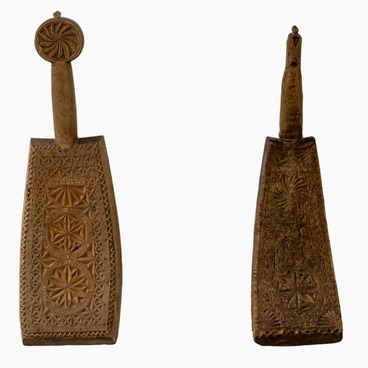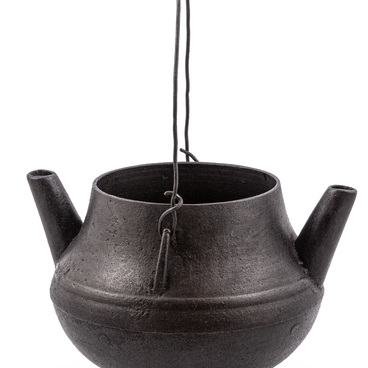Gingerbread board
Gingerbread is a traditional kind of dainty. Gingerbreads had appeared in Russia by the IXth century, at that time they were called “honey bread”. Recipes and ways of cooking gingerbreads were different, but gingerbreads “Pechatnye” (printed) were the most popular.
Gingerbread board is a wood board with a picture carved on it. The picture is an inverted image, as in the looking-glass. The board for gingerbreads is carved from soft broadleaf wood. The quality of the broadleaf wood had to be high-quality without knots and rot. Print on the pastry was fulfilled with the help of this board.
Some gingerbread boards meant for everyday use, the others were created specially for definite days and events, for example, for weddings and other festivals. The process of gingerbread creation was called printing, gingerbreads created with the help of the board were called printed.
The main themes for gingerbread board decoration were oriental ornaments, folk symbols, western motives and themes devoted to people’s way of life around.
The first records about gingerbread boards in Russia appeared in the XVIIth century when spices for making gingerbread pastry were brought from abroad.
In the XVIIIth century in Russia Matwey Voroshin was one of the gingerbread board masters. He lived in Gorodets and was busy with wood carving. Voroshin was the author of numerous heraldic and tower-room compositions.
Some gingerbread boards were used for making print for one or two gingerbreads. But there were gingerbread boards which could make print even for 120 gingerbreads.
Plant and animal motives with various ornamental patterns were characteristic features for gingerbreads. Some of extant old gingerbread boards were made of trunk bottom of the birch or pear-tree. To make gingerbread boards more solid their edges were coated with wax. Only after this procedure a pattern was drawn on the board.
Production of gingerbread boards was set up in Gorodets. Gorodets gingerbread boards were supplied to other cities too. Also, production of gingerbread boards was developed in Moscow, Tula, Vyaz’ma, Arkhangelsk and Vologda.
The size and relief of the gingerbread board were carried out taking into consideration the function of the future gingerbreads. Boards intended for making zazdravnyh, present and wedding gingerbreads were the biggest. Their length was about 1 arshine (71 cm), their width was about 12 vershkov (54 cm). Zazdravnyi gingerbread is a big gingerbread with a special print — a picture and wishes to have good health.
Характерной особенностью для пряников были растительные или животные мотивы с разными орнаментами. Некоторые из старых досок, сохранившихся до наших времён, изготавливались из нижней части ствола берёзы или груши. Чтобы доски были прочнее, их края смазывали воском. Только после выполнения этих процедур на доску наносился рисунок.
Размер и рельефы доски изготавливались с учётом назначения будущих пряников. Пряничные доски, предназначающиеся для изготовления заздравных, подарочных и свадебных пряников, были самыми большими. Их длина составляла около 1 аршина (71 сантиметр), а ширина была около 12 вершков (54 сантиметра).


